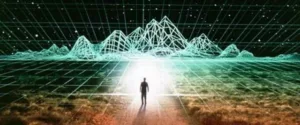There are three terms that have been getting increasing coverage first there was Virtual Reality largely connected to gaming where reality is replaced by rendered images, then came Augmented Reality were rendered images were placed over real objects and most recently we have holography where real and rendered images displace each other. Each technology has its advantages and disadvantages and each technology isn’t necessarily mutually exclusive. Let’s talk about the differences this week and how they eventually will create a magical world.
Virtual Reality
The mechanism for this is basically a screen, like Oculus Rift, which you place over your eyes obscuring the real world. Of the three technologies this is likely the cheapest with regard to headgear because you can repurpose a high end Smartphone to be the display and simply buy an inexpensive headset to get it to work. While this is best for gaming you could use to give virtual tours but any movement is at risk because, unless your environment is programmed into the system and objects are accurately geo located, you are going to hurt yourself if you move around. This typically requires a lot of graphics horsepower to render things realistically which means these headsets work best if tethered to a high performance workstation and with a game designed for VR use. This has resulted in the creation of 2D treadmills which allow movement without injury.
So the hardware is relatively inexpensive unless you need to move, or want extremely realistic real time rendering, and the best use is entertainment.
Augmented Reality
Augmented Reality is potentially more expensive because you have to use a dedicated headset and the headset needs both a camera and some form of location technology so it knows where it is. Qualcomm’s Vuforia and Google Glass are the best known offerings. Google Glass projected an image into your eye overlaying but not displacing any other image. Kind of like a personal heads up display it is handy for navigation, labeling what you are looking at, and even projecting items that are concealed (like pipes and wiring in walls) on objects you can see. The level of emersion is vastly reduced from VR making this less useful for gaming and far more useful for more practical purposes like reading instructions while working on a project or checking out the menus of the restaurants you are walking or driving by.
Companies like BMW are currently looking at offering this technology with their cars and providing real time navigation that works both in and out of the car, the ability to look through metal body panels and see curbs for better parking, and a form of heads up display.
Holographics
Holographics, best highlighted by Microsoft’s Hololens, blends elements of VR and AR to create something very different. Like VR the display covers the entire eye (or pretty close in its current form) and like AR there is a camera, or in this case cameras, and a form of geolocation like GPS built in. Unlike VR you can see through the lens at reality and unlike AR real objects may be obscured or completely replaced by virtual objects. The goal is for the viewer to be unable to distinguish between rendered objects and real objects. This allows a Virtual environment to become an overlay over a real environment but physical elements incorporated into the vision.
While initially this product is likely better for business than fun in its eventual implementation you could actually choose the reality you want to live in. If you wanted to see a Steam Punk world you could do that, if you want to see ghosts or spirits you could do that as well. Linked to intelligent systems you could call a cab with your voice or with a wand, and the cab could appear as a car or as some kind of flying carpet.
Wrapping Up: The Birth of Magic
In the end, with Hololens, what we are approaching is the ability to create a world indistinguishable from one where magic actually works. Perception is 100% of reality and we are talking about being able to eventually alter what people perceive. You want to look handsome or beautiful it is as easy as a command, you want to change the color, style or even architecture of a room or building that too is a command. Eventually whatever you imagine could be made to seem real and you could actually create the impression you can teleport to another part of the world or even to Mars. Of course Mars is where the folks currently using Hololens in beta are actually going.
Makes me wonder if I shouldn’t think about opening a school and calling in Hogwart’s to get ahead of the curve.








